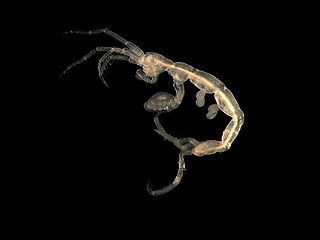
Amphipoda is an order of malacostracan crustaceans with no carapace and generally with laterally compressed bodies. Amphipods range in size from 1 to 340 millimetres and are mostly detritivores or scavengers. There are more than 9,900 amphipod species so far described. They are mostly marine animals, but are found in almost all aquatic environments. Some 1,900 species live in fresh water, and the order also includes the terrestrial sandhoppers such as Talitrus saltator and Arcitalitrus sylvaticus.

Astacidea is an infraorder of decapod crustaceans including lobsters, crayfish, and their close relatives.

Caprellidira is a parvorder of marine crustaceans of the infraorder Corophiida. The group includes skeleton shrimps (Caprellidae) and whale lice (Cyamidae).

Gammaridea is one of the suborders of the order Amphipoda, comprising small, shrimp-like crustaceans. Until recently, in a traditional classification, it encompassed about 7,275 (92%) of the 7,900 species of amphipods described by then, in approximately 1,000 genera, divided among around 125 families. That concept of Gammaridea included almost all freshwater amphipods, while most of the members still were marine.
Dexaminidae is a family of amphipods. It contains the following genera:

Corophiida is an infraorder of amphipods that contains the two parvorders Caprellidira and Corophiidira.
Phliantidae is a family of isopod-like amphipod crustaceans chiefly from the southern hemisphere.

Talitridae is a family of amphipods. Terrestrial species are often referred to as landhoppers and beach dwellers are called sandhoppers or sand fleas. The name sand flea is misleading, though, because these talitrid amphipods are not siphonapterans, do not bite people, and are not limited to sandy beaches.

The Hyperiidea are a suborder of amphipods, small aquatic crustaceans. Unlike the other suborders of Amphipoda, hyperiids are exclusively marine and do not occur in fresh water. Hyperiids are distinguished by their large eyes and planktonic habitat. Most species of hyperiids are parasites or predators of salps and jellyfish in the plankton, although Themisto gaudichaudii and a few relatives are free-swimming predators of copepods and other small planktonic animals.

The Ocypodidae are a family of semiterrestrial crabs that includes the ghost crabs and fiddler crabs. They are found on tropical and temperate shorelines around the world.

Leucothoidae is a family of amphipods. It contains 138 species in 5 genera:

Sphaeromatidae is a family of isopods, often encountered on rocky shores and in shelf waters in temperate zones. The family includes almost 100 genera and 619 known marine species. Within these genera, there are groups that share distinctive morphologies; further research may reclassify these genus-groups as separate families.
The taxonomy of the Gastropoda, as revised by Winston Ponder and David R. Lindberg in 1997, is an older taxonomy of the class Gastropoda, the class of molluscs consisting of all snails and slugs. The full name of the work in which this taxonomy was published is Towards a phylogeny of gastropod molluscs: an analysis using morphological characters.

The Idoteidae are a family of isopod crustaceans. It includes these genera:

Apogastropoda was previously used as a major taxonomic grouping of sea snails, marine gastropod molluscs. This infraclass mostly consisted of marine limpets and operculate snails. At least 20,000 species were considered to exist within the two clades that were included, Heterobranchia and Caenogastropoda.

Cymothoida is the name of a suborder of isopod crustaceans with a mostly carnivorous or parasitic lifestyle. It contains more than 2,700 described species in four superfamilies. Members of the suborder are characterised by their specialised mouthparts which include a mandible with a tooth-like process which is adapted for cutting or slicing.

Caprelloidea is a superfamily of marine crustaceans in the order Amphipoda. It includes "untypical" forms of amphipods, such as the skeleton shrimps (Caprellidae) and whale lice (Cyamidae). The group was formerly treated as one of the four amphipod suborders, Caprellidea, but has been moved down to the superfamily rank by Myers & Lowry after phylogenetic studies of the group, and is now contained in the infraorder Corophiida of the suborder Senticaudata. The group includes the following families.

Senticaudata is one of the four suborders of the crustacean order Amphipoda. It includes some 5000 species, which is more than 50% or the currently recognized amphipod diversity.

Caprella unica is a species of skeleton shrimp in the genus Caprella within the family Caprellidae. The larvae are plankton-like. They are relatively small, with two large and two small antennae. They only live in the sea, and are widely found in Cape Cod, Maine and Newfoundland.

Maeridae is a family of marine amphipods, which was first described by Taudl Krapp-Schickel in 2008.















